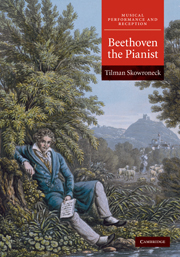Book contents
- Frontmatter
- Contents
- Acknowledgments
- Abbreviations and conventions
- Introduction
- PART I BEETHOVEN, HIS PLAYING, AND HIS INSTRUMENTS
- Introduction
- 1 Beethoven's early training
- 2 Beethoven the pianist
- 3 Beethoven's first decade in Vienna
- 4 The 1803 Érard grand piano
- PART II SOUND IDEAL AND PERFORMANCE
- PART III SOUND IDEAL, NOTATION, AND STYLISTIC CHANGE
- Epilog
- Bibliography
- Index
3 - Beethoven's first decade in Vienna
from PART I - BEETHOVEN, HIS PLAYING, AND HIS INSTRUMENTS
Published online by Cambridge University Press: 06 July 2010
- Frontmatter
- Contents
- Acknowledgments
- Abbreviations and conventions
- Introduction
- PART I BEETHOVEN, HIS PLAYING, AND HIS INSTRUMENTS
- Introduction
- 1 Beethoven's early training
- 2 Beethoven the pianist
- 3 Beethoven's first decade in Vienna
- 4 The 1803 Érard grand piano
- PART II SOUND IDEAL AND PERFORMANCE
- PART III SOUND IDEAL, NOTATION, AND STYLISTIC CHANGE
- Epilog
- Bibliography
- Index
Summary
THE FIRST YEAR
Beethoven's first year in Vienna is in fact not very well documented. We do know that he had financial troubles after the death of his father on December 18, 1792, when he had to ensure that he received his rightful salary from Bonn. A late source, addressing his first months in Vienna, says that he generally had “a miserable time.” Anton Schindler writes that, upon his arrival, Beethoven carried letters of introduction from the Elector Max Franz to various prominent persons in Vienna. He claims that Baron van Swieten became one of Beethoven's first and most influential friends, even though Beethoven's connection to the Lichnowsky family was “the most important” one, but gives no exact dates for Beethoven's introduction in these circles. Theodor Frimmel suspects that it was Count Waldstein (and not the Elector) who helped to “open all the doors” to Beethoven, since he was acquainted with “almost all the high nobility of Austria.”
It is, in any case, impossible to create a detailed account of Beethoven's activities based on the scanty material dating from the first year. However, one can establish a chronology of the information that has to do with his keyboard playing and his first musical contacts. Beethoven's first year unfolds as follows.
By the time Beethoven moved to Vienna in November 1792, he no longer considered any keyboard instrument other than a fortepiano suitable for his private use.
- Type
- Chapter
- Information
- Beethoven the Pianist , pp. 64 - 84Publisher: Cambridge University PressPrint publication year: 2010



